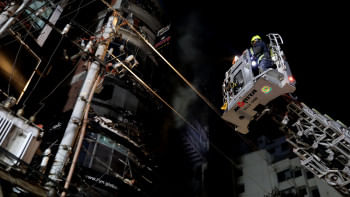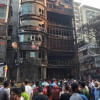Nimtoli to Bailey Road: Where is the justice for fire-related deaths?

On a Thursday night in Belgium, which corresponds to late night in Dhaka, I found myself browsing Facebook before going to bed. My Facebook feed was empty. So, I scrolled through Prothom Alo online for the latest news. One headline caught my eye: "Bailey Road building fire, at least 42 dead." Another tragic catastrophe had struck, claiming the lives of innocent people.
The scene was all too familiar—flames engulfing, smoke billowing, and trapped individuals suffocating. How tragic it is for a middle-class family, after a busy week, to go out for dinner on a Thursday evening with their loved ones, only to face such a horrific fate. This is not the first time such a disaster has occurred in Dhaka, and sadly, it won't be the last.
Five years ago, on February 21, 2019, a Friday morning, the residents of Old Dhaka's Chawkbazar faced a night of horror. Tragically, at least 70 individuals lost their lives in the catastrophic fire, which was exacerbated by the presence of a chemical warehouse beneath the building. The incident evoked vivid memories of the Chowhati fire, where the impact of a cylinder explosion was starkly captured as a man was hurled and his body shattered.
A month later, in March of the same year, a fire ravaged Banani's FR Tower, claiming the lives of 27 individuals. Our office was near FR Tower, and I witnessed firsthand people jumping out of the upper floors in a desperate bid to escape the flames. I saw how some clung to small dish-antenna cables for dear life.
These incidents are not isolated. The Tazreen Garments fire in Gazipur, the Moghbazar cylinder explosion in 2021, and the infamous Savar Rana Plaza collapse in 2013, where 1,134 lives were lost, are etched in our collective memory. Rana Plaza, once a symbol of exploitation, is now a case study in factory safety worldwide. Before all these, the Nimtoli fire in 2010 claimed the lives of at least 267 people.
The pattern is clear—tragedies strike, lives are lost, but justice remains elusive. None of these incidents have led to proper prosecution or identification of those responsible. Take, for example, the Churihatta fire of 2019. A victim's son filed a court case, and after three years, the police completed the investigation. In February 2022, eight individuals, including two owners of Waheed Mansion, were found guilty. Among them were six owners of chemical warehouses. Charges were framed in January the following year, yet all accused were granted bail. Despite 167 witnesses, none have been cross-examined.
It has been 11 years since the Rana Plaza tragedy, and justice still eludes the families of the 1,134 victims. Meanwhile, Dhaka has become a ticking time bomb, with an estimated 25,000 chemical warehouses in Old Dhaka alone, 15,000 of which are under residential buildings. According to reports of Fire Service and Civil Defence, only two percent of these factories, shockingly, have institutional approval.
Efforts to relocate these hazardous warehouses have been met with little success. Despite calls to move them after the Chawkbazar fire, not a single warehouse has been shifted. Instead, the number of unregistered factories is on the rise. Living in a building with a chemical warehouse beneath it is akin to living on the edge of death.
Adding to the peril is the burgeoning restaurant business, with biryani stalls cropping up in residential and commercial buildings without proper permits. Dhanmondi, Uttara, Gulshan, and Banani, once relatively safe, are now teeming with food stalls on every floor. Emergency exits are blocked, building designs altered for aesthetic appeal, and safety regulations ignored.
In the wake of recent tragedies, questions abound on social media. Why is action taken only after a disaster strikes? Where is the accountability? Why have those responsible for these disasters not been brought to justice? How can people safeguard themselves against such horrific deaths?
Bangladesh's rapid urban growth, particularly in Dhaka, has made it one of the world's busiest cities. By 2030, Dhaka is projected to be the fifth largest city in the world in terms of population. However, this growth has been marred by unplanned expansion and poor governance, making Dhaka increasingly unliveable. From air pollution to noise pollution, Dhaka ranks among the worst cities in the world in various civic indicators.
After the Chawkbazar fire, promises were made to relocate every factory and chemical warehouse to Keraniganj. Yet, as far as I know, those promises have faded into obscurity. The government-sponsored inquiry committee after the Nimtoli incident made 17 recommendations, including shifting chemical warehouses, ensuring building code compliance, establishing hydrant points, and creating awareness in schools. Sadly, none of those recommendations have been implemented.
The deficiencies in our fire service and civil defence are glaring. Lack of modern equipment, specialised manpower, and infrastructure exacerbate the risks. The city's traffic gridlock further hampers emergency response efforts. Yet, little has been done to address these deficiencies.
We cannot continue in this manner. A bustling city of nearly 20 million people cannot be left to its own devices, waiting for the next tragedy to strike. It's time for accountability, action, and a collective effort to make Dhaka a safer place for all its residents.
Mohammed Norul Alam Raju is a development professional, currently studying development policy and management in Belgium.
Views expressed in this article are the author's own.
Follow The Daily Star Opinion on Facebook for the latest opinions, commentaries and analyses by experts and professionals. To contribute your article or letter to The Daily Star Opinion, see our guidelines for submission.

 For all latest news, follow The Daily Star's Google News channel.
For all latest news, follow The Daily Star's Google News channel. 










Comments